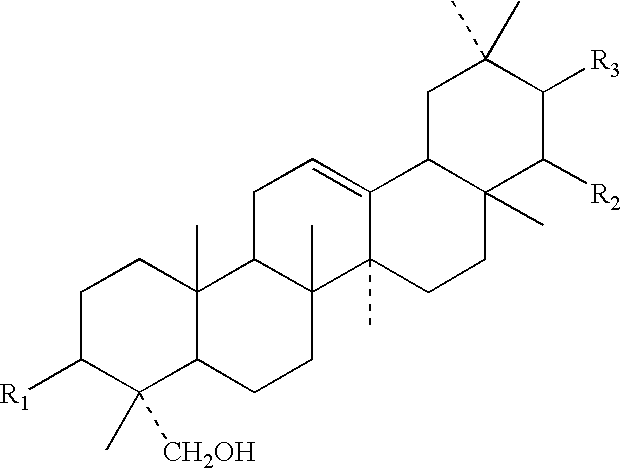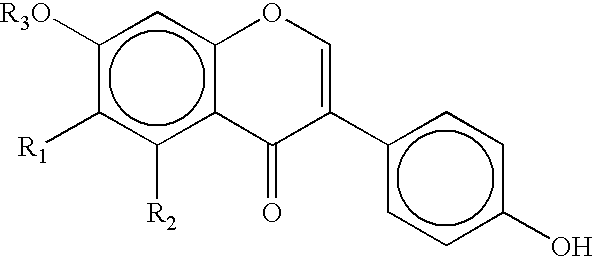Methods of treatment using a soya extract
a technology of soya extract and treatment method, applied in the field of new extracts, can solve the problems of high public expenditure and great social and psychological damage to those affected, and achieve the effect of reducing deliberate alcohol consumption
- Summary
- Abstract
- Description
- Claims
- Application Information
AI Technical Summary
Benefits of technology
Problems solved by technology
Method used
Image
Examples
example 1
Production of Soya Extract Having an Isoflavone Content of 15% By Weight and a Ratio of Glucoside Isoflavones / group B Soya Saponins of 1:1.5 By Purification with Solvents
[0080]10 kg of oil-freed soya flour containing 0.2% of glucoside isoflavones and 0.3% of group B soya saponins are refluxed five times with 30 l of 95% strength ethyl alcohol. The alcohol extracts are mixed and concentrated under reduced pressure to 5 l. The concentrate is diluted with 1.5 l of water and extracted four times with 5 l of n-hexane. The hexane phase is discarded and the concentrated alcohol phase is extracted four times using 2.5 l of n-butanol. The organic phase is concentrated and dried under reduced pressure. 133 g of extract having an isoflavone content of 15% by weight and a group B soya saponin content of 22.5% by weight are obtained.
[0081]An HPLC diagram of an extract obtained by the process of this example is shown in FIG. 1.
example 2
Production of a Soya Extract Having an Isoflavone Content of 15% By Weight and a Ratio of Glucoside Isoflavones / group B Soya Saponins of 1:1.5 By Purification on Polystyrene Resin
[0082]The aqueous concentrate produced in Example 1 is not extracted with n-butanol, but treated with polyethoxylated castor oil (Cremophor®), to dissolve the resinous residues from the concentration of the alcohol phase. It is then applied, suspended in purified water (5 l), to a column of XAD1180 resin. The column is then flushed with water for complete removal of salts, sugars and surface-active agents and then eluted with about 10 l of 95% strength ethyl alcohol. After concentrating and drying the ethanol eluate, 130 g of extract having the same composition as that of the extract obtained in Example 1 are obtained.
example 3
Production of a Soya Extract Having an Isoflavone Content of 43% By Weight and a Ratio of Glucoside Isoflavones / group B Soya Saponins of 1:1
[0083]200 g of the extract obtained in Example 1 or 2 are suspended in 1 l of aqueous 20% strength ethyl alcohol and diluted with 0.5 l of ethyl acetate. The suspension is subjected to a countercurrent heating with vigorous stirring until complete dissolution and then left for the course of one night. The saponins precipitated out (38 g, purity 93%) are isolated by filtration and the ethylacetate- and water-containing aqueous mother liquor is separated off. The organic phase is concentrated under reduced pressure and dried. The isoflavone residue—37 g having a purity of 81%—is dissolved in 1 l of ethyl alcohol and admixed with 32 g of crystallized saponins, in order to obtain a product which contains isoflavones and saponins in a weight ratio of 1:1. The alcoholic solution is concentrated to dryness under reduced pressure and gives 69 g of extra...
PUM
| Property | Measurement | Unit |
|---|---|---|
| Fraction | aaaaa | aaaaa |
| Percent by mass | aaaaa | aaaaa |
| Percent by mass | aaaaa | aaaaa |
Abstract
Description
Claims
Application Information
 Login to View More
Login to View More - R&D
- Intellectual Property
- Life Sciences
- Materials
- Tech Scout
- Unparalleled Data Quality
- Higher Quality Content
- 60% Fewer Hallucinations
Browse by: Latest US Patents, China's latest patents, Technical Efficacy Thesaurus, Application Domain, Technology Topic, Popular Technical Reports.
© 2025 PatSnap. All rights reserved.Legal|Privacy policy|Modern Slavery Act Transparency Statement|Sitemap|About US| Contact US: help@patsnap.com



